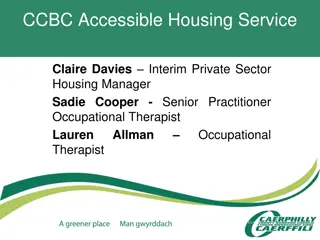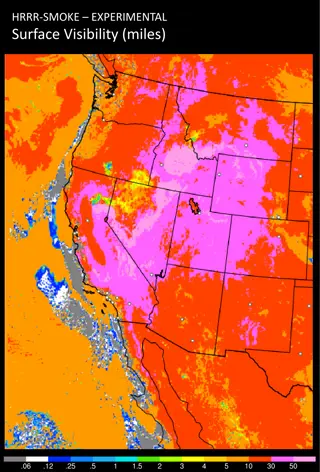Benefits of Smoke-Free Housing in Colorado
Smoke-free housing in Colorado offers numerous advantages, including improving business outcomes, reducing health risks, lowering maintenance costs, and enhancing property values. By implementing smoke-free policies, property owners can protect residents' health, reduce fire risks, minimize cleaning and repair expenses, and attract more tenants. These policies also lead to decreased utility bills, less air treatment system usage, and increased overall property value. Furthermore, smoke-free housing contributes to a healthier and safer living environment for both residents and staff members.
Download Presentation

Please find below an Image/Link to download the presentation.
The content on the website is provided AS IS for your information and personal use only. It may not be sold, licensed, or shared on other websites without obtaining consent from the author.If you encounter any issues during the download, it is possible that the publisher has removed the file from their server.
You are allowed to download the files provided on this website for personal or commercial use, subject to the condition that they are used lawfully. All files are the property of their respective owners.
The content on the website is provided AS IS for your information and personal use only. It may not be sold, licensed, or shared on other websites without obtaining consent from the author.
E N D
Presentation Transcript
Smoke-Free Housing Is Good for Business Good for Health
Multiunit residential buildings in Colorado that prohibit smoking anywhere inside and near buildings or for the entire property: 7,300+ buildings with 166,000units. 25% of those policies cover the entire property. 2,700+ buildings managed by 66 housing authorities. mysmokefreehousing.com 2
Reduces the costs of cleaning and repairing carpets, furniture, fixtures, window treatments, priming and painting walls, and general maintenance. Lowers utility bills and decreases the use of air- treatment systems 30% less according to estimates by Marriott Hotels). 3
Reported costs for damage caused by smoking $4,500 to $8,000 normal damage $6,000 to $ 12,000 more extensive damage Normal turnover costs $500 to $2000 American Lung Association in Colorado 2015 study of four housing authorities and one affordable living community 4
Fire risks and fire damage are reduced. Lower insurance premiums may be possible, check with your insurance provider. Improves property values because there is less damage caused by smoking and discarded cigarettes. 5
Cigarettes may cause an average of 5% of all residential fires. 36% of all residential fire fatalities 14% of residential fire injuries, and 7% of all residential property loss. Colorado State Fire Chiefs Association 2010 6
Spend less time dealing with smoking-related complaints. Protect the health of your residents and workers including staff and maintenance. Free advertising with listings at mysmokefreehousing.com. 7
Residents reported that smoke- free policies reduced their respiratory problems once the policies were implemented. 8
85% of adults in Colorado do not smoke. 89.5% of Colorado households report having no-smoking rules. 63.5% of Coloradans think that smoking should not be allowed in multiunit residential buildings. 9
Coloradans are used to being protected from exposure to secondhand smoke in workplaces, restaurants, bars, and public places due to state and local laws. They also expect clean indoor air in their dwellings. People with chronic conditions are especially impacted when secondhand smoke drifts into their residences. 10
Those Who Implement No-Smoking Policies Never Want to Go Back Not one of the housing providers that prohibits smoking regrets doing so and none are considering going back to allowing smoking in any unit where it has been prohibited. Many said that once they tried it in one property, they quickly wanted it in all. Research by Campbell DeLong Resources, Inc. An independent market-research firm based in Portland, Oregon 11
While we have certainly seen some exciting market opportunities for businesses over the years, we rarely see such obvious ones. Frankly, if a private property-management firm had conducted this research, it might be tempted to keep the findings confidential to gain an initial competitive advantage. Campbell DeLong Resources, Inc. Portland, Oregon 12
Implementing no-smoking policies in more than 200 Denver area apartment buildings that Cornerstone manages has been one of the best decisions I have made over the last 20 years. It has significantly reduced maintenance, repair and turnover costs. Furthermore, residents and staff love it. Jim Lorenzen, President, CornerstoneApartment Services, Incorporated Denver, Colorado 13
Secondhand smoke cannot be controlled using ventilation or air- cleaning systems. Up to 50% of the air in multiunit housing may be re-circulated throughout an entire building. The American Society of Heating, Refrigerating, and Air Conditioning Engineers (ASHRAE) sets the industry standards for ventilation. ASHRAE recommends prohibiting all smoking activity in multifamily buildings to protect residents, staff and visitors from the health effects of exposure to secondhand smoke. 14
The policy should cover all types of smoking, including tobacco, marijuana, and vaping. Involve residents in the process. Determine their opinions and needs using surveys before and after implementation. Talk to other housing providers who have no-smoking policies. 15
Provide the policy terms, effective date, and consequence of violations through meetings, in person, and in writing with signatures of all parties. Educate residents about the health impact to neighbors and how smoking increases the fire risk. Consult an attorney to draft a policy that works for you and complies with local and state laws. 16
Create a plan to obtain policy compliance with residents, management, staff and contractors. Inform neighboring property owners about the policy and whom to best contact about any concerns. 17
Plan a phase-in period and set an effective date for the policy to be implemented. A 12-to 18-month period is recommended. Make no exceptions to the policy as they can create resident confusion, frustration, and distrust of management. Exceptions make enforcement more difficult and may lead to fair-housing or false-advertising complaints. Provide stop-smoking resources like the Colorado Quitline at 1-800-QUIT-NOW and tobaccofreeco.org. 18
Smoking should be prohibited: In all indoor areas and units. On balconies, patios, and porches. At all outdoor common areas. At least 25-feet away from any part of a building. 19
Using no-smoking or nonsmoking is more appropriate if smoking is allowed on balconies, patios, porches or in designated areas on a property. Why? Residents and staff may still be exposed to secondhand smoke which could lead to fair- housing or other legal complaints. 20
Using smoke-free is appropriate if smoking is prohibited everywhere on the property. The number of smoke-free multiunit properties has increased significantly in the last five years. Useful for LEEDs or green point credits. Easier to enforce and reduces complaints. 21
A 2015 American Lung Association study of Colorado housing providers found that a 100% smoke- free policy is easier for residents and staff to understand, and for management to enforce. 22
Communicate the policy to prospective residents, employees, and visitors on a continual basis. Use signage, newsletters and advertising. Be clear that both guests and staff need to follow the policy. Visit the property frequently to observe compliance and establish a protocol for dealing with violations. 23
Document and investigate complaints promptly and take appropriate actions to ensure compliance. Consider using mediation as a way to resolve issues with compliance if necessary. Offer residents a safe and anonymous way to report violations. Maintain good sign placement throughout the property such as the international no-smoking symbol. Thank your staff, managers, and residents for their cooperation and help. 24
The indoor air quality ishealthier for everybody and protects everyone from the exposure to secondhand smoke. Safety lowers fire risks for residents and families. Everybody is welcome people who smoke are welcome but will have to go outside and away from all buildings to smoke. Less building damage and maintenance may help management keep rental rates stable. Respect for your neighbors smoke has no boundaries and can travel between units. 25
The findings from the American Lung Association 18-month study provides some important insights for housing providers on the benefits of smoke-free policies, implementation and enforcement techniques, and the opinions of heads of household. mysmokefreehousing.org 26
Tips on how to implement a policy. Compliance techniques and other resources. Sample leases. HUD toolkits. Health information on secondhand tobacco and marijuana smoke. 27
MySmokeFreeHousing.com Lists thousands of multiunit residential buildings in Colorado with no-smoking or smoke-free policies. Listings are free. TobaccoFreeCO.org Information about the Colorado Clean Indoor Air Act and tobacco prevention. 28
Local or state tobacco-prevention programs may be able to assist housing providers with: Surveys and implementation steps. Sample policies and educational materials. Guidance and assistance. Smoking-cessation resources and information. Free signage. 29
Pete Bialick Group to Alleviate Smoking Pollution (GASP of Colorado) 303-444-9799 gaspforair.org The Colorado Group to Alleviate Smoking Pollution (GASP) is a 501-c-3 statewide nonprofit organization founded in 1977. Through education and policy change, GASP works to save lives by striving to eliminate the exposure to secondhand smoke at work, in public places, and in multiunit housing. No one should be forced to breathe secondhand smoke, whether it is from tobacco or marijuana smoking or the aerosols emitted by electronic smoking devices. 30























